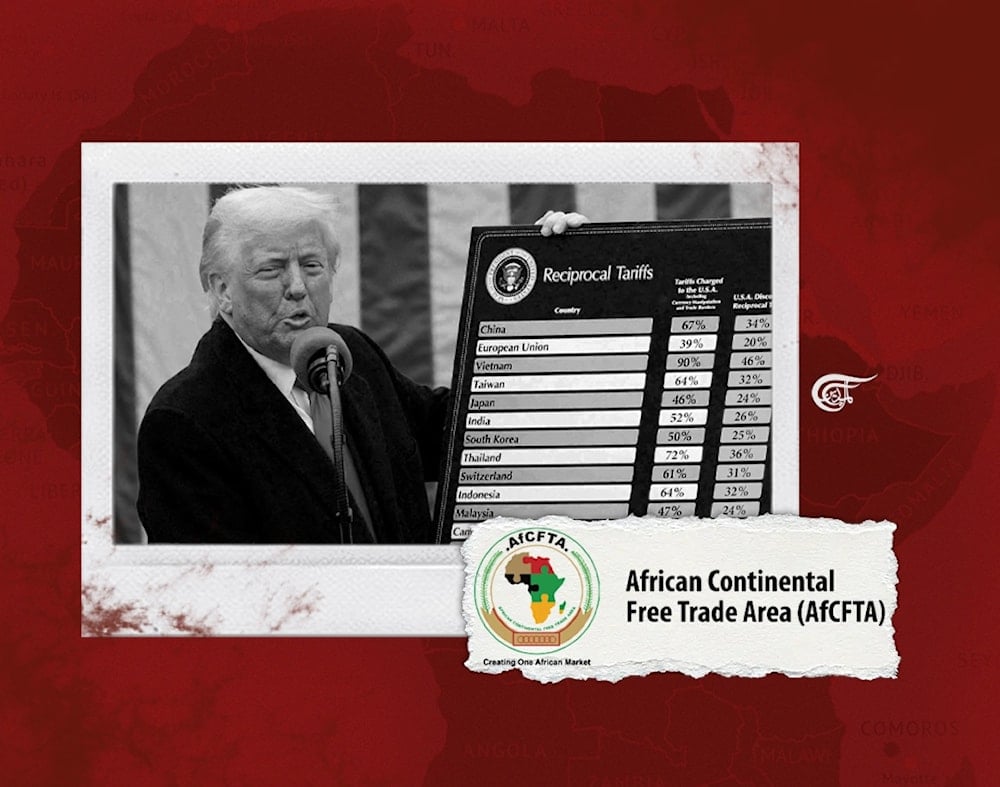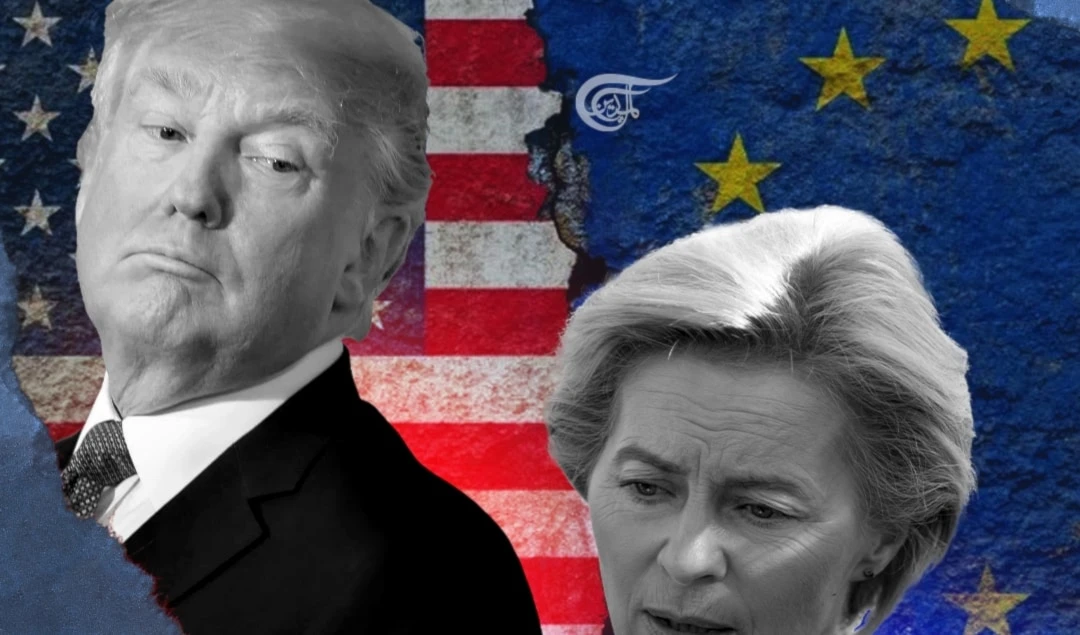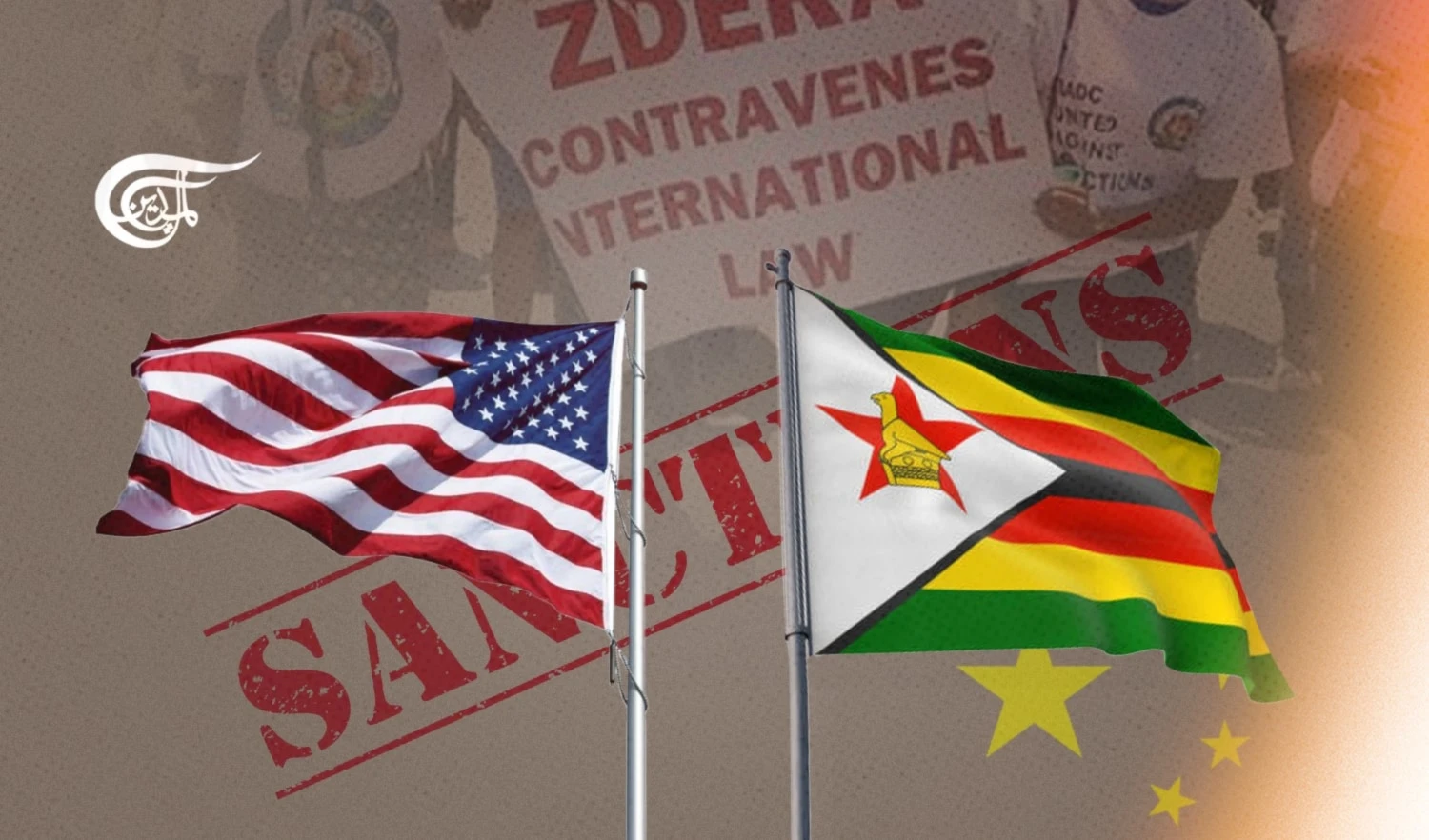Hopes that Trump’s tariff tantrum quickens African Continental Free Trade Area dream
As countries plot their response to Trump’s tariff tantrum, analysts say that for Africa, in the midst of this potential for hardship, lies an opportunity for the continent to speed up the march towards its goal of continental economic integration.
-

Analysts say the ripple effects of US tariff policies are weighing heavily on African markets, especially for countries that have long relied on preferential access through AGOA. (Al Mayadeen English; Illustrated by Zeinab El-Hajj)
From South Africa to Egypt, from Madagascar to Togo, the African continent is in confusion on how to respond to US President Donald Trump’s newly imposed harsh tariffs. Experts warn that the uncertainty triggered by this blizzard of “reciprocal” tariffs could ultimately reshape the global economic order. In the short term, however, the proposed tariff regime threatens to destabilise African economies that are already burdened by mounting debt, sluggish growth, and shrinking foreign aid.
‘Death knell for AGOA’
Calculated through metrics that most economists find to be questionable, the tariffs spell doom for the African Growth and Opportunity Act (AGOA), a 25-year-old piece of US legislation guaranteeing duty-free access to American markets for certain goods from 32 eligible sub-Saharan African countries. Widely celebrated as the hallmark of US-Africa economic relations, the aim of the trade pact, based on a philosophy of replacing aid with trade, was to help industrialise the continent, create employment, and lift dozens of countries out of poverty.
But on April 2, Trump hit all but two (Burkina Faso and Seychelles) countries on the 54-nation continent with the new “reciprocal” tariffs. For these 52 African countries, 30 of them face the “baseline” 10% tariff, while 22 others will face tariffs up to 50% for almost all their products, excluding a short list of products such as some minerals that are strategic to the US economy.
Divisions emerge
By April 9, when Trump announced a 90-day pause for his tariffs on all countries but China, few African countries had formulated responses to the tariffs, highlighting the state of paralysis into which they had been thrown.
Despite the existence of a continental trade bloc and several regional ones, there appears to be no movement towards a unified position, as individual countries are seen making their own decisions, highlighting the deep divisions that already exist within the continent.
Kenya sent a delegation to Washington, and South Africa, whose relationship with the US is at it lowest point, has been considering doing the same.
Although he is currently the chairman of the Southern African Development Community (SADC), a 16-nation regional economic bloc, Zimbabwe’s President Emmerson Mnangagwa announced a zero-tariff policy in response to Trump’s 18% tariff in what he said was a goodwill gesture by Zimbabwe, which was excluded from AGOA, meant to promote better trade relations with the US. His knee-jerk move elicited criticism from many who feel it was not well considered.
Apart from seeking revocation or reduction of tariffs, some of the countries are looking for alternative markets for their exports, in addition to making plans to buy more US goods to help balance trade.
An opportunity to quicken AfCFTA implementation
Analysts say the ripple effects of US tariff policies are weighing heavily on African markets, especially for countries that have long relied on preferential access through AGOA. Countries hit by the tariffs like Lesotho (50%) and South Africa (30%) are seeking alternatives by reinforcing regional trade through frameworks like the African Continental Free Trade Area (AfCFTA) as well as pursuing new bilateral trade agreements.
African trade experts say the continent can make use of the 90-day suspension of the tariffs to come up with a common position on responding to the Trump tariff tantrum in a way that does not harm regional integration, but actually fast-tracks the implementation of the AfCFTA agreement.
The AfCFTA agreement of 2018, signed by 54 African Heads of State, seeks to create a single African market of 1.3 billion people with a combined Gross Domestic Product of $3.4 trillion. It hopes to eliminate tariffs on 90 percent of goods traded between member states over ten years.
Munyaradzi Munaro, an international relations analyst, says while the 90-day pause of tariffs has given relief to some African countries, the long-term strategy is to grow intra-African trade.
“This is a crisis which also brings with it a chance for African states to rethink their trade policies and to go into greater economic integration via the AfCFTA”, Munaro told Al Mayadeen English.
“By grasping this chance African states can reduce their export dependency on foreign markets, develop a more diverse and stable trade regime, and put forth their trade and economic interests.”
He said the AfCFTA gives a stage for African states to increase their trade and economic cooperation which in turn reduces their dependence on traditional export markets like the US, China, and the European Union.
“By shifting their focus to other African countries for export markets, African states may in fact see a lessening of the tariffs’ impact and at the same time sustain their economic growth. For example, in the case of Nigeria – Africa’s largest economy – it can increase trade with other West African countries like Ghana and Cote d’Ivoire which are large markets for its agricultural products. South Africa, which is a large producer of steel and aluminum, also has the chance to shift its exports to other African countries like Egypt and Morocco which are big consumers of these products. The African Development Bank reports that the AfCFTA may see Nigeria’s trade with other African countries rise by up to 15% while South Africa’s may see an increase of up to 20%.”
Vince Musewe, an African economist also sees the potential presented by AfCFTA, though he says some stumbling blocks need to be cleared first. He said, “AfCFTA is the silver bullet to lift Africa in many ways, especially forcing the emergence of new trade infrastructures and allowing the ease of movement of goods and services across borders. However, the central issue is regional politics and economic policies, which are not integrative in nature. Old colonial legacies and divisions still hold us back. The potential benefits are evident to all, yet the political will is mixed across the continent. East Africa seems to be ahead”.
Intra-Africa trade in long term
Professor Albert Makochekanwa, the director of the University of Zimbabwe Business School, is, however, cautious about the speed at which African economies can grow intracontinental trade, given that most of them are primarily geared towards the export of raw materials.
“There is a possibility for increased intra-African trade, but in the long run. As of now, African economies export products that are all in raw form, and they are not directly related to important items needed for life. For instance, Zimbabwe exports raw diamonds, which are not directly related to what people want. While another country out there exports diamonds, jewelry like diamond rings, necklaces etc, are products that people want”, Prof. Makochekanwa said.
He added that African economies' export basket is composed of competing products, as opposed to complementary products; hence, intra-African trade is very low.
“What do I mean? Competing products means Malawi produces and exports maize, and Zimbabwe also does the same. Meaning these two countries cannot trade much. Complementary trade means Malawi produces and exports maize, say, to South Africa, South Africans in turn agro-process and manufacture, say, biscuits, cornflakes, etc, and export to Malawi.”
He pointed out that the continent also needs to work on its transport and logistics, border delays, roadblocks, poor road and railway infrastructure, which he says makes internal trade in Africa costly.
Since the Trump tariffs were announced, Joseph Kalimbwe, a Zambian political analyst and pan-African activist has taken to his social media pages to share some of the absurdities of African trade, which he says are not helpful to the spirit of regional economic integration.
“Tanzania spends $85 million on sugar from India (yet) next door, Zambia produces over 400,000 tons. Angola spends $244 million on sugar from Brazil (yet) South Africa in SADC is largest sugar producer. We spend half a billion on sugar from across oceans when we can buy it from our own brothers and sisters within SADC!
“South Africa spends $262 million per year on beef from Brazil (yet) Botswana has 14 000 tons of beef. Angola buys $57 million fish from Argentina per year (yet) Namibia next door is the largest fish producer. We can have $32 billion rotating and building our SADC economies per year, creating jobs and reducing deficits. But we don’t trust each other.”

 Cyril Zenda
Cyril Zenda
 8 Min Read
8 Min Read











